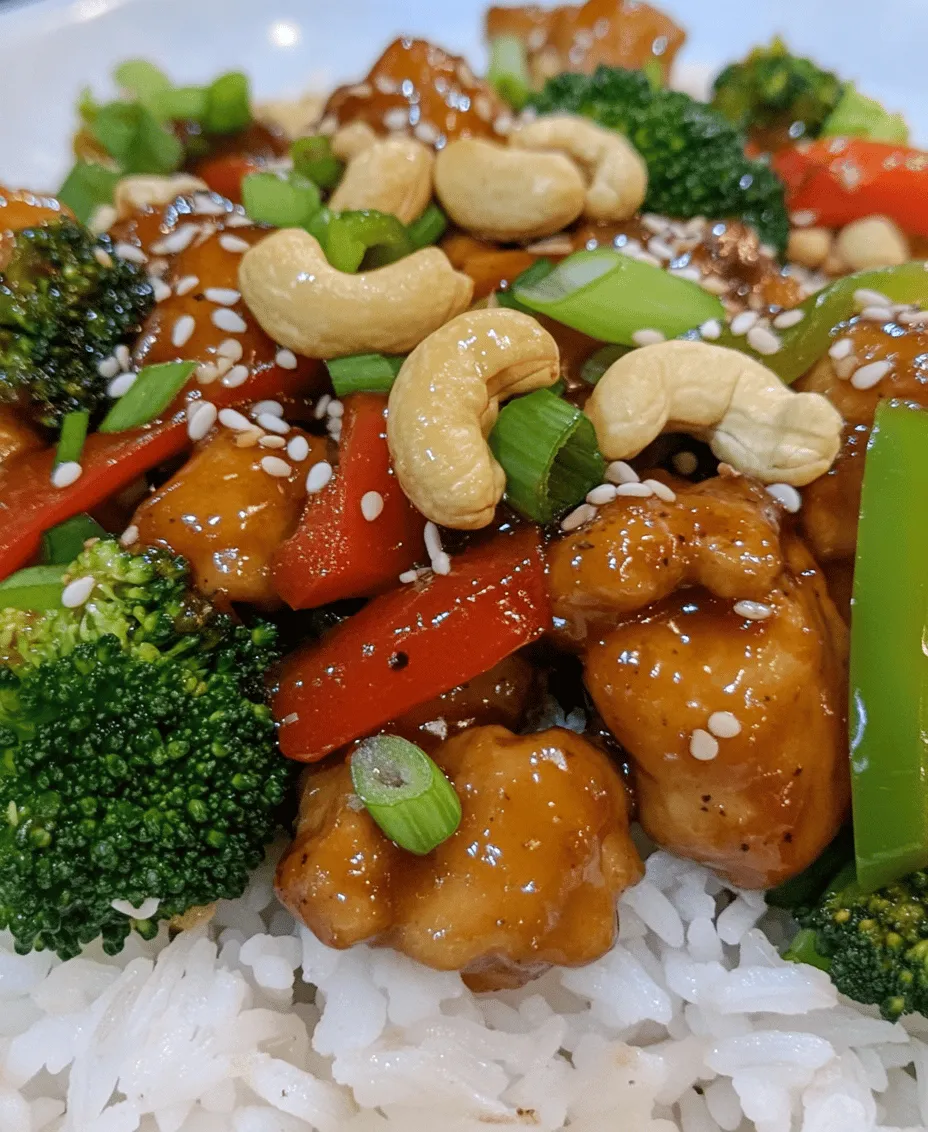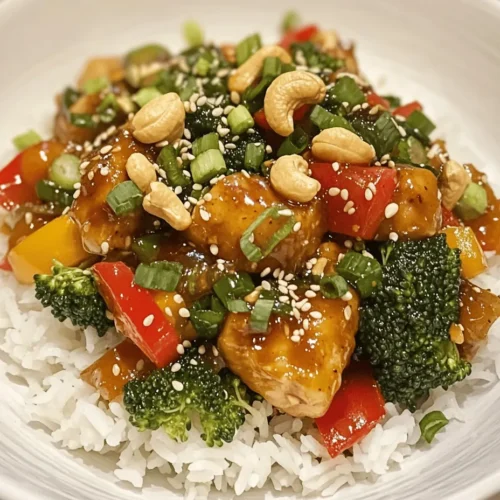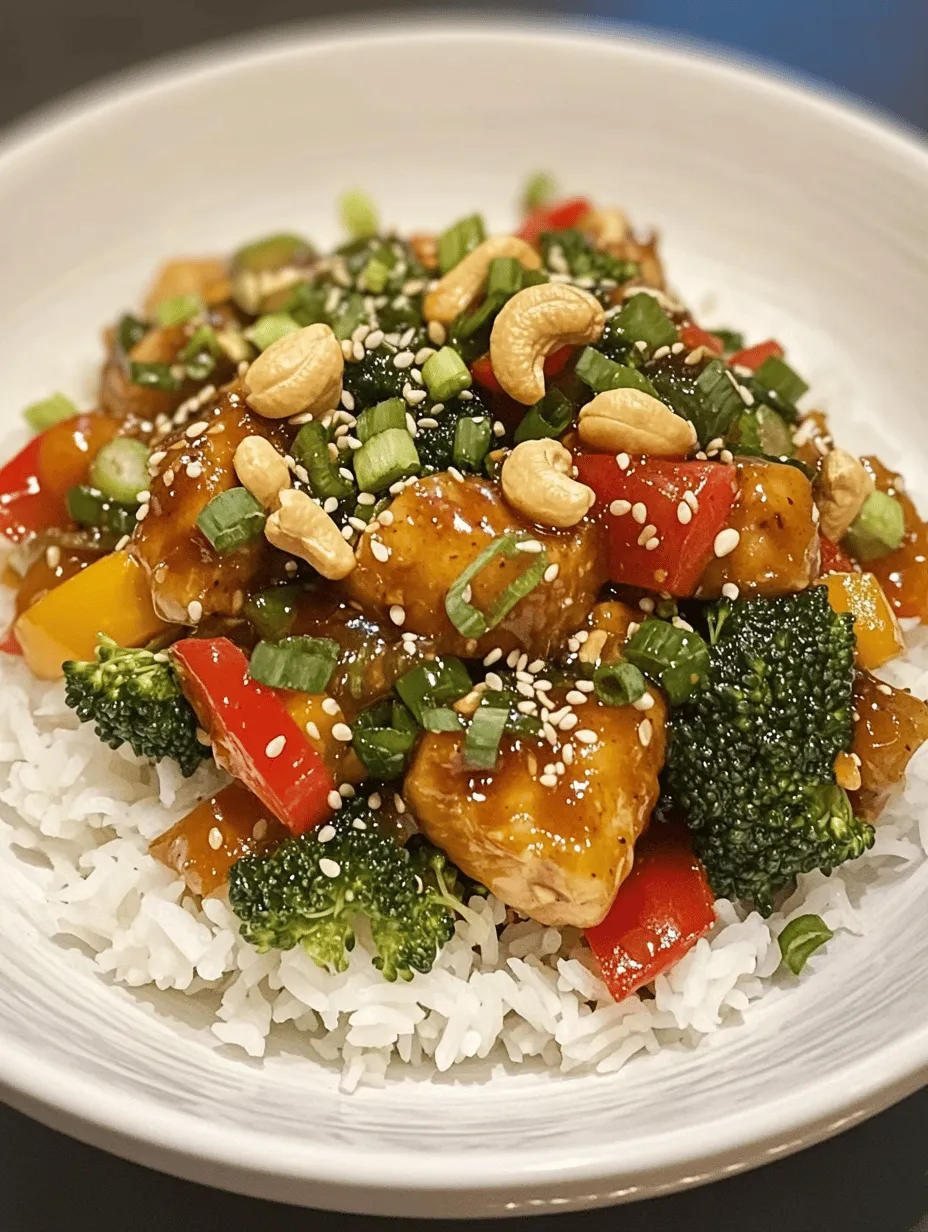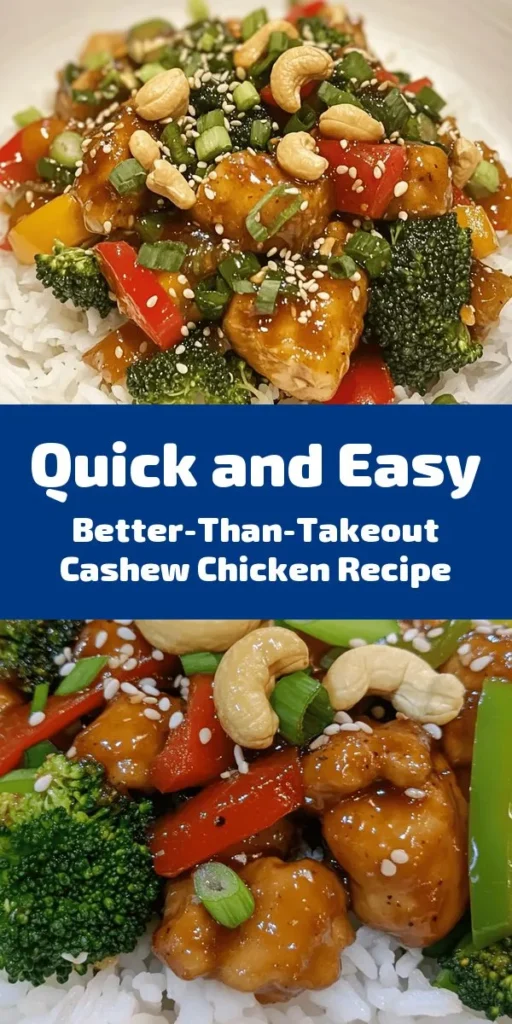Introduction
In today’s fast-paced world, takeout has become a staple for many households seeking convenience and flavor without the hassle of cooking. However, while takeout offers a quick solution to meal times, it often comes with a heavy price tag and can be loaded with unhealthy ingredients. This is where homemade alternatives shine, providing a healthier and more satisfying option. One dish that has gained immense popularity in the takeout realm is Cashew Chicken. This delightful stir-fry dish is known for its tender chicken, crunchy cashews, and vibrant vegetables, all enveloped in a savory sauce.
Enter our Better-Than-Takeout Cashew Chicken recipe—your go-to dish that not only rivals your favorite Chinese restaurant but also brings a healthier twist to your dinner table. This recipe is perfect for those busy weeknights when you crave something delicious yet quick to prepare. With a total cooking time of under 30 minutes, you can whip up this flavorful meal without sacrificing time or taste.
Understanding the Ingredients
To create the best Better-Than-Takeout Cashew Chicken, it’s essential to understand the primary ingredients and their roles in the dish. Each component contributes to the overall flavor, texture, and nutritional value, making it a well-rounded meal.
Chicken
At the heart of this dish is boneless, skinless chicken breasts. This lean protein source not only provides essential amino acids but also helps keep the calorie count in check. When cooked properly, chicken breast becomes tender and juicy, serving as the perfect canvas to absorb the flavors of the marinade and sauce. Additionally, opting for skinless chicken reduces saturated fat intake, making this recipe a healthier option compared to traditional takeout.
Cashews
Cashews are the star of this dish, adding both texture and healthy fats. These nuts are rich in monounsaturated fats, which are beneficial for heart health. Their creamy, slightly sweet flavor complements the savory elements of the dish beautifully. When toasted, cashews become even more aromatic, enhancing the overall flavor profile of the Better-Than-Takeout Cashew Chicken. Plus, they add a satisfying crunch that contrasts with the tender chicken and vegetables.
Fresh Vegetables
Incorporating fresh vegetables into your Cashew Chicken not only elevates the dish’s flavor but also boosts its nutritional profile. Common vegetables used in this recipe include bell peppers, broccoli, and carrots. Bell peppers add sweetness and color, while broccoli contributes a hearty crunch and a plethora of vitamins. Carrots bring a subtle earthiness and a vibrant hue, making the dish visually appealing. Together, these vegetables provide essential nutrients such as vitamins A and C, fiber, and antioxidants.
Sauces
The sauce is where the magic happens in Cashew Chicken. The combination of soy sauce, oyster sauce, hoisin sauce, rice vinegar, and cornstarch creates a rich umami flavor that is both savory and slightly sweet.
– Soy Sauce: This classic ingredient is the base of the sauce, imparting a deep, salty flavor that enhances the chicken and vegetables.
– Oyster Sauce: This sauce adds a complex sweetness and umami depth, commonly found in Asian cuisine.
– Hoisin Sauce: Known for its rich, sweet flavor, hoisin sauce contributes to the overall complexity of the dish and balances the saltiness of soy sauce.
– Rice Vinegar: A splash of rice vinegar adds acidity, brightening the flavors and preventing the dish from feeling too heavy.
– Cornstarch: This ingredient acts as a thickening agent, giving the sauce a glossy finish that clings to the chicken and vegetables.
For those with dietary restrictions, there are plenty of alternatives available. For instance, gluten-free soy sauce can be used to accommodate those with gluten sensitivities, while vegetarian oyster sauce can replace the traditional version for a plant-based dish.
Marinating the Chicken
An essential step in preparing Better-Than-Takeout Cashew Chicken is marinating the chicken. This process is crucial for enhancing both flavor and tenderness.
Importance of Marination
Marinating chicken breast not only infuses it with flavor but also helps break down the proteins, resulting in a more tender bite. The combination of soy sauce, minced garlic, and fresh ginger in the marinade is particularly effective. Soy sauce introduces saltiness and umami, while garlic and ginger provide aromatic qualities that elevate the overall taste of the dish.
Step-by-Step Marination Process
1. Prepare the Marinade: In a bowl, combine ¼ cup of soy sauce, 2 cloves of minced garlic, and 1 tablespoon of freshly grated ginger. Mix well to ensure all ingredients are fully incorporated.
2. Marinate the Chicken: Cut the boneless, skinless chicken breasts into bite-sized pieces for even cooking. Place the chicken in the marinade, ensuring each piece is well-coated. Cover the bowl with plastic wrap or transfer everything to a resealable plastic bag.
3. Refrigerate: Allow the chicken to marinate in the refrigerator for at least 15-30 minutes. If time allows, marinating for a few hours or even overnight will yield even better results.
Variations in Marination
While the basic marinade is delicious on its own, feel free to experiment with additional flavors. For a touch of sweetness, you might add a teaspoon of sugar or honey to the marinade. For those who enjoy a bit of heat, incorporating red pepper flakes or Sriracha can add a delightful kick to the chicken.
Preparing the Sauce
The sauce is the heart of the Better-Than-Takeout Cashew Chicken, bringing together all the elements for a cohesive dish. Understanding the components of the sauce will help you prepare it perfectly.
Sauce Components
1. Soy Sauce: The foundation of the sauce, providing that essential umami flavor.
2. Oyster Sauce: Adds depth and a hint of sweetness.
3. Hoisin Sauce: Introduces a unique flavor profile that balances the savory elements.
4. Rice Vinegar: Brightens the sauce and cuts through the richness.
5. Cornstarch: When mixed with a bit of water to create a slurry, it thickens the sauce, giving it the perfect consistency.
Impact of Each Ingredient
The careful balance of these ingredients is what makes the sauce so irresistible. The soy sauce brings saltiness, while the oyster sauce contributes a rich, savory flavor. Hoisin adds sweetness, and rice vinegar provides acidity, creating a well-rounded taste that complements the chicken and vegetables perfectly. The cornstarch ensures that the sauce has a desirable thickness, allowing it to cling to the chicken and vegetables, ensuring that every bite is flavorful.
Alternative Sauces
For dietary preferences, there are alternatives to consider. For a vegetarian version, replace the oyster sauce with mushroom sauce to maintain that umami depth. If you’re looking for a gluten-free option, ensure you are using gluten-free soy sauce and check that your other sauces meet your dietary needs.
Cooking Techniques
The cooking method you use for Better-Than-Takeout Cashew Chicken is crucial for achieving optimal results. Sautéing and stir-frying are the key techniques here, allowing you to create a dish that is both quick and flavorful.
Importance of Cooking Methods
Using high heat and a quick cooking method is essential for maintaining the texture and moisture of the chicken. Sautéing the chicken at the right temperature ensures it browns beautifully while remaining juicy inside. Stir-frying the vegetables at high heat allows them to retain their crunch and vibrant color, enhancing the dish’s visual appeal.
Tips for Perfectly Sautéed Chicken
1. Preheat the Pan: Start by heating a large skillet or wok over medium-high heat. Adding oil once the pan is hot will prevent the chicken from sticking and allow it to sear properly.
2. Use the Right Amount of Oil: A tablespoon of oil should be sufficient to coat the pan. Too much oil can lead to a greasy dish, while too little may cause sticking.
3. Don’t Overcrowd the Pan: Cooking the chicken in batches, if necessary, ensures that each piece gets the proper sear. Overcrowding can lead to steaming rather than sautéing, resulting in uneven cooking.
4. Watch for Visual Cues: Cook the chicken until it turns golden brown on the outside and is no longer pink on the inside. This usually takes about 5-7 minutes, depending on the size of the pieces.
By following these tips, you’ll be well on your way to creating a dish that not only rivals your favorite takeout but surpasses it in flavor and nutrition.
With the ingredients, marination, sauce preparation, and cooking techniques outlined, you are ready to embark on your journey to crafting the ultimate Better-Than-Takeout Cashew Chicken. In the next section, we will delve into the final steps of combining all the elements to create this delicious meal.

Stir-frying is a pivotal technique in Asian cuisine, especially for dishes like Cashew Chicken, where the aim is to retain both the crispness of vegetables and their vital nutrients. When stir-frying, high heat is essential, as it cooks the ingredients quickly while preserving their texture and flavor. The quick cooking process ensures that vegetables, such as bell peppers, broccoli, and snap peas, not only stay vibrant in color but also maintain their crunch. This is crucial, as the freshness of the vegetables contributes significantly to the overall enjoyment of the dish.
Combining Ingredients
Once your chicken is marinated and your vegetables are prepped, it’s time to bring all the components together to create a harmonious and delicious dish. Start by heating a large wok or skillet over medium-high heat. The goal here is to create a hot environment that allows for quick cooking, which is essential for stir-frying.
1. Cooking the Chicken: Add a tablespoon of oil to the hot wok and let it swirl around to coat the surface evenly. Introduce the marinated chicken pieces, ensuring they are spread out in a single layer. Avoid overcrowding the pan, as this would cause steaming instead of searing. Cook the chicken for about 4-5 minutes, turning it occasionally until it is golden brown and cooked through.
2. Adding Vegetables: With the chicken nearly done, it’s time to add your vegetables. Start with the firmer vegetables, such as bell peppers and carrots, which require a bit more time to cook. After a couple of minutes, toss in the softer vegetables like snap peas and broccoli. Stir-frying these together creates a beautiful medley of colors and textures.
3. Coating with Sauce: As everything cooks, you’ll need to add your sauce. Pour the pre-prepared sauce over the chicken and vegetables, making sure to stir thoroughly. A tip to ensure even coating is to lift the chicken and vegetables from the bottom of the pan, allowing the sauce to reach all parts of the dish.
4. Thickening the Sauce: Continue cooking for an additional 2-3 minutes. This step is crucial as it allows the sauce to thicken slightly and meld with the chicken and vegetables, creating a cohesive and flavorful dish. The heat helps evaporate excess liquid, intensifying the flavors and making the sauce cling beautifully to your ingredients.
The Final Touch: Adding Cashews and Serving
No Cashew Chicken is complete without the crunchy cashews that give the dish its name. To maintain their delightful texture, add the cashews just a minute or two before serving. This brief exposure to the heat will warm them without losing their crunch, providing that perfect bite that contrasts beautifully with the tender chicken and crisp vegetables.
When it comes to presentation, plating your Cashew Chicken can elevate the dining experience. Serve it over a bed of fluffy steamed rice or quinoa, allowing the grains to soak up the delicious sauce. For a pop of color and an added flavor dimension, garnish with freshly chopped green onions and a sprinkle of sesame seeds. The visual appeal of the dish can make it even more enticing, inviting everyone to dig in.
Serving Suggestions
Cashew Chicken is versatile and pairs excellently with various side dishes. Here are some recommendations to complement your meal:
– Steamed Rice: A classic pairing, the fluffy texture of steamed white or brown rice absorbs the savory sauce perfectly.
– Fried Rice: For a more indulgent option, serve your Cashew Chicken with vegetable fried rice, which adds another layer of flavor.
– Quinoa: For a healthier alternative, consider quinoa, which adds a nutty flavor and extra protein.
If you have leftovers, store them in an airtight container in the refrigerator for up to three days. Reheat in a skillet over medium heat to maintain the dish’s integrity. The flavors may deepen overnight, often making the leftovers even tastier.
When it comes to drinks, consider pairing your Cashew Chicken with a refreshing iced green tea or a light white wine like Sauvignon Blanc. These beverages complement the dish without overpowering its flavors.
Nutritional Breakdown
One of the many benefits of making Cashew Chicken at home is the ability to control the nutritional content. This dish is packed with protein from the chicken and healthy fats from the cashews, making it a balanced meal.
– Protein: Chicken is an excellent source of lean protein, essential for muscle repair and growth.
– Healthy Fats: Cashews provide heart-healthy fats, which are crucial for overall health.
– Vitamins and Minerals: The vegetables add a wealth of vitamins (such as Vitamin C from bell peppers) and minerals (like potassium from broccoli), contributing to a well-rounded nutritional profile.
When considering portion sizes, aim for a balanced plate: about one-quarter filled with protein (chicken), one-quarter with healthy fats (cashews), and half with vegetables and grains. This approach ensures a fulfilling meal that supports a balanced diet.
Cultural Context
Cashew Chicken has its roots in Chinese cuisine, particularly influenced by the Cantonese cooking style that emphasizes the use of fresh ingredients and quick cooking methods. While the dish has become popular in various countries, particularly in the United States, it often varies in preparation and ingredients based on regional preferences.
Homemade versions of Cashew Chicken not only taste better than takeout but also allow for customization based on personal dietary preferences. Unlike takeout, which can be high in sodium and unhealthy fats, cooking this dish at home gives you the opportunity to use fresh ingredients and control the seasoning. This way, you can enjoy a flavorful meal without compromising on health.
Conclusion
Making Better-Than-Takeout Cashew Chicken at home offers numerous advantages: it’s healthier, customizable, and provides an opportunity to enjoy the cooking process. There’s something immensely satisfying about preparing a meal from scratch and sharing it with family and friends.
As you explore this recipe, don’t hesitate to experiment with different vegetables or proteins. Perhaps you want to try tofu for a vegetarian version, or add more spices for a kick. The beauty of cooking lies in its flexibility, allowing you to make each dish uniquely yours.
So, gather your ingredients, follow the steps, and relish the joy of creating this delightful dish in your kitchen. Your Better-Than-Takeout Cashew Chicken is just a stir-fry away from becoming a staple in your home-cooked repertoire.



